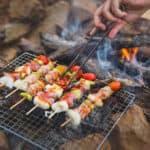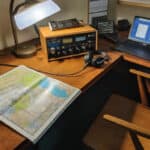As water bills creep up and dry spells get longer, many of us search for ways to keep our gardens green and our taps flowing. Rainwater harvesting isn’t just an age-old practice; it’s a smart move in today’s world, where fresh water is becoming a scarce resource.
This article dives into simple yet effective methods to collect and purify rainwater, ensuring you have a reliable supply for your home needs. “Stay tuned,” we’re unlocking the secrets of the skies!
Table of Contents
- Understanding Rainwater Harvesting
- Techniques for Collecting Rainwater
- Converting Rainwater into Drinkable Water
- How to Make Rainwater Safe for Other Uses
- Benefits of Using Harvested Rainwater
- Conclusion
- Can Rainwater Collection Techniques Be Used for Cleaning and Maintaining Campfire Cookware?
- FAQs
- What are rainwater harvesting tanks, and how do they help conserve water?
- Can collected rainwater be safe for drinking?
- Are there green solutions for collecting rainwater in cities?
- How does filtration work in purifying rainwater?
- Why is chlorine added to stored rainwater?
- What’s the difference between non-potable and potable water after purification?
Key Takeaways
- Rainwater collection systems like rain barrels, dry systems, and wet systems can effectively reduce water bills and conserve municipal supplies by capturing rainfall for various uses such as garden irrigation and household tasks.
- Purification techniques such as UV light filtration, membrane filtration, and distillation ensure rainwater is safe to drink by removing harmful bacteria, viruses, chemicals, and debris from the collected water.
- Using harvested rainwater for plants promotes healthier growth because it lacks the chlorine found in tap water; if used for bathing or other personal care routines, it’s gentler on the skin due to its natural softness.
- Implementing rainwater harvesting practices reduces environmental impact by decreasing stormwater runoff, which can carry pollutants into ecosystems, while also lessening dependency on groundwater sources.
- By embracing sustainable methods of collecting and purifying rainwater at home, we protect our environment and become a part of the crucial movement towards resource conservation.
Understanding Rainwater Harvesting
Rainwater harvesting captures and stores rain for later use. It’s a simple yet effective way to manage water resources, especially in areas with water scarcity. This technique collects rain from roofs, then directs it through gutters and downspouts into storage tanks or barrels.
From there, the stored water can be used for various purposes like irrigation or as part of a more complex plumbing system for indoor non-potable uses.
The beauty of this system lies in its versatility and sustainability. By collecting runoff before it hits the ground, we reduce stormwater runoff, which often carries pollutants into our ecosystems.
Storing rainwater also helps conserve municipal water supplies by providing an alternative source during dry spells or drought conditions. With proper design and maintenance, harvesting rainwater is a smart step toward environmental conservation and self-reliance when it comes to managing our most precious resource: water.
Techniques for Collecting Rainwater

Harnessing the bounty of the skies starts with efficient rainwater collection – a game-changer in how we manage our precious water resources. We’ll delve into innovative methods that capture every drop, transforming rooftops and landscapes into vital components of sustainable living.
Rain Barrels
Rain barrels serve as a straightforward and cost-effective way to collect rainwater for outdoor use. These receptacles connect to downspouts from gutters, capturing water that would otherwise contribute to runoff and potential flooding around the home.
By storing this water, homeowners can irrigate gardens, wash cars, or fulfill other household tasks without drawing on municipal supplies or well water. Utilizing these barrels is a step towards sustainable living as it reduces demand for conventional water sources and helps conserve one of the earth’s most precious resources.
These barrels come in various sizes and materials suitable for different needs and preferences. They are typically equipped with spigots for easy access to the stored water and screens to prevent debris from entering the tank.
With minimal maintenance, such as regular cleaning to avoid contamination and ensure proper winter storage, rain barrels prove their worth in creating self-sustaining systems that benefit both individual households and the wider community by conserving water.
Next up: exploring “Dry” System collection methods expands our knowledge of structuring efficient rainwater harvesting systems.
“Dry” System
The “dry” system stands out as a robust solution for capturing rainwater during those heavy downpours, which are few and far between. Geared toward large-volume collection, this method directs water from your roof through gutters and downspouts into sizable storage tanks.
This ensures you have an ample water supply, even when rain is not frequent.
Equipped with filters and screens to keep debris at bay, the dry system requires a comprehensive setup, including protective measures for gutters and indicators of water levels to maintain quality.
It’s also compatible with graywater systems, enabling homeowners to recycle this resource efficiently for non-potable uses like irrigation or flushing toilets, thereby conserving precious H2O and reducing overall water consumption.
“Wet” System
A “Wet” system takes rainwater collection to the next level by connecting underground pipes from multiple downspouts. This network allows a greater surface area to capture rain, channeling water into one cohesive system for high-volume storage and usage.
Installed beneath the ground, these systems are especially good fits for extensive rooflines or commercial properties that need substantial amounts of harvested rain.
With their ability to gather water from numerous gutters simultaneously, “Wet” systems offer increased capacity over simpler methods like standalone barrels. However, be prepared for higher initial costs and carefully consider your property’s layout; strategic placement is crucial for optimal functionality.
Despite their complexity, wet systems represent a smart investment toward sustainable practices in urban and rural areas facing water shortages or seeking environmental sustainability.
Converting Rainwater into Drinkable Water
Discover the transformative process of turning simple rainwater into a clean, sustainable source of drinking water, and stay tuned to learn innovative purification techniques that can be applied at home.
Using Ultra Violet (UV) lights
UV lights offer a powerful tool for making collected rainwater safe to drink. They work by exposing water to ultraviolet radiation, which attacks the genetic core of bacteria and viruses, effectively eliminating their ability to reproduce and cause harm.
This method is quick and energy-efficient, providing an eco-friendly alternative to more traditional methods like boiling or chemical treatment.
Installing a UV filtration system can be the key step in ensuring your rainwater becomes potable. Unlike chemical treatments that might leave an aftertaste or byproducts, UV purification keeps the water clean without adding anything unwanted.
As it flows through the system, every drop passes under these lights, coming out free from microorganisms that could pose health risks. It’s a straightforward process: no added heat or excessive power consumption – just simple science turning rainwater into clean drinking water.
Membrane Filtration
Membrane filtration stands out as a top-tier technique in purifying collected rainwater. This technology employs semi-permeable membranes to sift out contaminants, particles, and pathogens, greatly enhancing water quality.
Different types of membrane filters—such as microfiltration, ultrafiltration, nanofiltration, and reverse osmosis—are tailored for various levels of purification based on the size of impurities they target.
These systems can significantly reduce health risks by providing clean water for drinking and cooking.
Using membrane technologies transforms rainwater into a reliable source that rivals municipal water supply standards. Homeowners can confidently use this filtered water for potable needs and bathing without worrying about waterborne diseases.
As we turn our attention to other methods, such as distillation, adopting membrane filtration is an actionable step towards sustainable living and effective water conservation in any household or agricultural setting.
Distillation
Distillation transforms rainwater into safe drinking water by heating it until it turns into steam and then cooling that steam back into liquid. This process leaves behind many of the impurities, such as chemicals and heavy metals, which cannot evaporate.
It’s a powerful method for purification, ensuring that even those without access to clean water sources can enjoy purified water. However, distilling requires a significant amount of electrical power or another heat source, making it essential to weigh the energy costs against the benefits.
Implementing distillation involves setting up a system where rainwater is boiled, with the vapor then condensed on a cool surface away from the original liquid. As this happens, pathogens and debris are separated from the water since they do not convert into gas at boiling temperatures like H2O does.
While effective in removing unwanted substances from your collected rainwater, always pair this method with mechanical filtration to ensure you’ve thoroughly eliminated contaminants like dust particles, which may remain after boiling.
How to Make Rainwater Safe for Other Uses
Rainwater isn’t just for quenching thirst; it’s a multifaceted resource that, once properly treated, can meet various household needs. Let’s dive into the purification processes that unlock rainwater’s potential for nurturing gardens and enhancing your daily self-care rituals.
Rainwater for Plants
Plants thrive on rainwater for a key reason—it’s free of chlorine and chloramine found in tap water. These chemicals can inhibit plant growth by affecting the soil’s beneficial microbes.
Using harvested rainwater ensures your garden gets pure hydration without the added substances that often come with municipal water supplies. Moreover, using stored rainwater reduces strain on infrastructure and contributes to managing surface runoff, making it an eco-friendly choice for watering plants.
However, take caution when watering edible plants with collected rainwater; rooftop runoff might carry E. coli or other contaminants. It’s important to consider filtration systems if the water collected comes into direct contact with fruit or vegetable surfaces.
Employing simple methods such as solar energy-powered ultraviolet light can kill off harmful bacteria, making it safer for use in agriculture and home gardens alike. This proactive step not only preserves plant health but also guards against potential health risks—ensuring that harnessing nature’s gift is done responsibly and effectively.
Rainwater for Bathing
Using rainwater for your daily shower or bath can be a game-changer, especially because it is naturally soft water. This means it’s gentler on your skin and hair compared to the hard minerals found in many municipal water supplies.
Consider installing a UV lamp in the system to keep yourself safe and ensure the water is clean. It acts as an extra layer of protection, zapping any microorganisms that might still linger even after initial filtration.
Better yet, this practice conserves precious potable water reserves by utilizing collected rainwater instead. Imagine cutting down on utility bills while taking care of your personal hygiene needs and benefiting from rainwater’s natural softness! Ensure the storage tanks are well-maintained, clean, and properly sealed against contaminants like dirt or smoke — then enjoy a refreshing bath that’s both eco-friendly and economical.
Benefits of Using Harvested Rainwater
Harvest rainwater and watch your garden thrive without the harsh chemicals found in municipal water supplies. Plants respond better to natural rainfall; they grow more vigorously and appear more vibrant because rainwater is free of chlorine, fluorides, and other substances that can accumulate in soil over time.
This gentle water boosts microbial activity in the earth, helping roots absorb nutrients more effectively.
Collecting rainwater also significantly reduces stormwater runoff, which can erode landscapes and carry pollutants into local waterways. Homeowners who use rain barrels or build cistern systems take proactive steps towards managing excess runoff while securing an additional supply for outdoor tasks such as washing cars or irrigating lawns.
Notably, embracing harvested rainwater eases the strain on groundwater extraction—an action critical during times of drought or scarcity of water—thus preserving precious resources for future generations.
Conclusion
Harnessing the power of rainwater isn’t just a smart move – it’s an actionable step towards sustainability. With collection and purification techniques, we turn the sky’s bounty into a resource that reduces strain on water systems and our wallets.
Embrace these methods to conserve, enjoy pure water, and contribute positively to environmental health. Making the most of rainwater is an opportunity we should all catch!
Can Rainwater Collection Techniques Be Used for Cleaning and Maintaining Campfire Cookware?
Yes, rainwater collection techniques can be used for cleaning and maintaining campfire cookware. When using campfire cookware, it’s important to follow proper campfire cookware maintenance tips to ensure its longevity and cleanliness. Collecting rainwater can be a sustainable and effective way to clean your campfire cookware without using harsh chemicals.
FAQs
What are rainwater harvesting tanks, and how do they help conserve water?
Rainwater harvesting tanks collect rain from roofs and store it, making water available for use during shortages and helping to fight the water crisis by conserving this valuable resource.
Can collected rainwater be safe for drinking?
Yes, rainwater can become potable drinking water that’s safe to consume when properly purified using methods like reverse osmosis (RO), UV disinfection, or carbon filtration.
Are there green solutions for collecting rainwater in cities?
Green roofs act as living sponges that absorb rainfall; they capture run-off, reduce pollution, and cool buildings down, making cities more climate-resilient.
How does filtration work in purifying rainwater?
Filtration systems like membrane technology or charcoal filters remove contaminants such as dirt and organic material from rainwater to make it suitable for various uses, including watering plants and washing clothes.
Why is chlorine added to stored rainwater?
Chlorination is a disinfection technique that kills harmful bacteria and viruses in stored water, ensuring it’s clean enough for uses other than drinking, such as irrigation or flushing toilets.
What’s the difference between non-potable and potable water after purification?
Non-potable water has been collected but not yet treated enough for drinking; however, it can become potable drinking water through processes like distillation or reverse osmosis purification techniques.







Leave a Reply